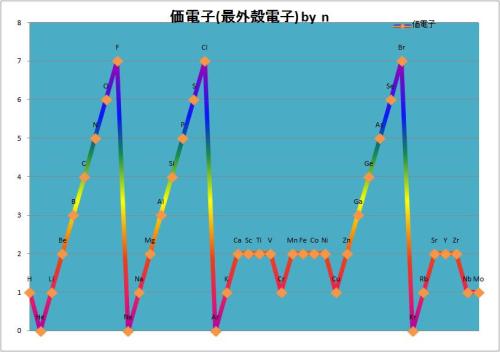カテゴリ: カテゴリ未分類
11mg の差
The nitrogen, obtained altogether in four ways from chemical compounds,is material lighter than the above, the difference amounting to about 11mg., or about 1/200 part of the whole.
この報文は、1894年に発表された "On an Anomaly encountered in Diterminations of the Density of Nitrogen Gas" の中の一部分
世紀末に、激震の議論の始まりだった。
大気からの窒素・・・・ 2.3100 g
化学物質からの窒素・・ 2.2990 g
この重量差・・・・・・ 0.011 g・・・・11mg
これが、周期表に一列の元素集団を付け加えることになる発端となろうとは、誰も予想しなかった。
そして、1895年に、レイリー卿とラムゼーは、「Argon, a New Constituent of Atmosphere 」を発表する。
窒素ガスの謎に迫った論文の軌跡を1892年から1895年の間に発表した論文リスト
197. Density of Nitrogen
[Nature, XLVI. pp. 512, 513, 1892.]
201. On the Densities of the Principal Gases
[Proceedings of the Royal Society, LIII. pp. 134149, 1893.]
210. On an Anomaly encountered in Determinations of the Density of Nitrogen Gas
[Proceedings of the Royal Society, LV. pp. 340344, April, 1894.]
214. Argon, a New Constituent of the Atmosphere.
By LORD RAYLEIGH, Sec. R.S., and PROFESSOR WILLIAM RAMSAY, F.R.S.
[Phil. Trans. 186 A, pp. 187241, 1895.]
215. Argon
そして、共同研究者であるラムゼーが、カナダのトロントで1897年におこなった講演
「An Undiscovered Gas」の中で予言したさらなる希ガス元素の存在。
すなわち、原子量 4のヘリウムと、原子量 39.88 アルゴンが発見されて、未知なる希ガスの存在についてである。原子量約20 原子量約82 原子量約130の三つの希ガス元素の予言である。
There should, therefore, be an undiscovered element between helium and argon, with an atomic weight 16 units higher than that of helium, and 20 units lower than that of argon, namely 20. And if this unknown element, like helium and argon, should prove to consist of monatomic molecules, then its density should be half its atomic weight, 10. And pushing the analogy still further, it is to be expected that this element should be as indifferent to union with other elements as the two allied elements.
ヘリウムとアルゴンとの間に、ヘリウムの原子量より16ユニット大きい、アルゴンより20ユニット小さい、ひとつの未発見元素があるにちがいない。
さらに、類推をすすめれば、二つの同類の元素のように、他の元素に対して無反応・無関係な元素だと予想される。
この講演から約10カ月後に新希ガスを発見している。
価電子元素表
The nitrogen, obtained altogether in four ways from chemical compounds,is material lighter than the above, the difference amounting to about 11mg., or about 1/200 part of the whole.
この報文は、1894年に発表された "On an Anomaly encountered in Diterminations of the Density of Nitrogen Gas" の中の一部分
世紀末に、激震の議論の始まりだった。
大気からの窒素・・・・ 2.3100 g
化学物質からの窒素・・ 2.2990 g
この重量差・・・・・・ 0.011 g・・・・11mg
これが、周期表に一列の元素集団を付け加えることになる発端となろうとは、誰も予想しなかった。
そして、1895年に、レイリー卿とラムゼーは、「Argon, a New Constituent of Atmosphere 」を発表する。
窒素ガスの謎に迫った論文の軌跡を1892年から1895年の間に発表した論文リスト
197. Density of Nitrogen
[Nature, XLVI. pp. 512, 513, 1892.]
201. On the Densities of the Principal Gases
[Proceedings of the Royal Society, LIII. pp. 134149, 1893.]
210. On an Anomaly encountered in Determinations of the Density of Nitrogen Gas
[Proceedings of the Royal Society, LV. pp. 340344, April, 1894.]
214. Argon, a New Constituent of the Atmosphere.
By LORD RAYLEIGH, Sec. R.S., and PROFESSOR WILLIAM RAMSAY, F.R.S.
[Phil. Trans. 186 A, pp. 187241, 1895.]
215. Argon
そして、共同研究者であるラムゼーが、カナダのトロントで1897年におこなった講演
「An Undiscovered Gas」の中で予言したさらなる希ガス元素の存在。
すなわち、原子量 4のヘリウムと、原子量 39.88 アルゴンが発見されて、未知なる希ガスの存在についてである。原子量約20 原子量約82 原子量約130の三つの希ガス元素の予言である。
There should, therefore, be an undiscovered element between helium and argon, with an atomic weight 16 units higher than that of helium, and 20 units lower than that of argon, namely 20. And if this unknown element, like helium and argon, should prove to consist of monatomic molecules, then its density should be half its atomic weight, 10. And pushing the analogy still further, it is to be expected that this element should be as indifferent to union with other elements as the two allied elements.
ヘリウムとアルゴンとの間に、ヘリウムの原子量より16ユニット大きい、アルゴンより20ユニット小さい、ひとつの未発見元素があるにちがいない。
さらに、類推をすすめれば、二つの同類の元素のように、他の元素に対して無反応・無関係な元素だと予想される。
この講演から約10カ月後に新希ガスを発見している。
価電子元素表
お気に入りの記事を「いいね!」で応援しよう
【毎日開催】
15記事にいいね!で1ポイント
10秒滞在
いいね!
--
/
--
PR
X
キーワードサーチ
▼キーワード検索
カレンダー
ストリップスを使わ…
 New!
mabo400さん
New!
mabo400さん
このところ、自転車… New! alex99さん
間違いをていせいし… New! Hirokochanさん
今日咲いてる秋バラ… New!
萌芽月さん
New!
萌芽月さん
御朱印でめぐる茨城… ジャンボ青木さん
ジャンボ青木さん
 New!
mabo400さん
New!
mabo400さんこのところ、自転車… New! alex99さん
間違いをていせいし… New! Hirokochanさん
今日咲いてる秋バラ…
 New!
萌芽月さん
New!
萌芽月さん御朱印でめぐる茨城…
 ジャンボ青木さん
ジャンボ青木さんコメント新着
フリーページ
化学

C 60 フラーレン

カーボンナノチューブ

化学物質管理

特定有害化学物質

初級化学講座1

HLB

色素増感

黄砂

C 60周辺

ch01

開始剤

化審法

真空

マイクロカプセル

水 一

水 2

絶対わかるシリーズ

レア-アース・レアーメタル

I 131

アンチモン

メタンハイドレート

遷移金属元素

化学図録

セシウム吸蔵

スカンジウム回収

ICSC

五酸化バナジウム

高分子

チタン酸ストロンチウム

原子の電子配置

星間炭素鎖分子

酒石酸・・パスツールに至るまで

熱学思想

酸素発見から原子・分子論へ

元素の定義

メンデレーエフの野望

元素アナグラム

パスツールの動機
多面体から見える化学

化学 正四面体からの始まり (1)(2)

化学 正四面体からの始まり (3)(4)

化学 正四面体からの始まり (5)(6)

化学 正六面体(1)

正六面体 (2) 真空の発見

正六面体 (3) 近代化学

正六面体 (4) 原子論

バスカルの真空

ガリレオガリレイの真空
商品紹介

電波時計

アクセス

砂時計

防災懐中電灯・ラジオ

保存食・パン

USB メモリー

観葉植物

ロールスクリーン

海ぶどう

うどん

カリー
風景 四季の花のページ

カモメ

サギ集団

美松

合歓の木

古いポンプ

むくげ

老木

不明

曼珠沙華

ルコウ

アロエ

カモメ2007

ヤマブキ

復刻

ランタナ

シンピジューム

親子

梅

琵琶湖の夕暮れ

ノハラツグミ
四季の風景

危機管理

稲田

対応2

隠元橋 ドッキング前と後

木幡緑道

さつき

古墳

虹

鳥居

エピトロコイド曲線 マルチ番外
環境・品質 ISOの無駄話

品質記録

外部監査

続 二

内部監査

再構築

工程管理要領

統合

ISO/TS16949基礎知識

shall項目

FMEA

活動2007.5

認定基準

コアーツール

方向違い 080313

QC七つ道具

エネルギー1

改善の機会
安全管理・危機管理

OHSMS 1

安全管理1

化学安全

防止対策

危機管理
滋賀文化ゾーン

夕照庵
初級化学講座

ボルタ
未題

第一章 メール

ファラディ, マイケル
法律 関連法

消防法

改正労働安全衛生法

法 GHS

火災予防条例

改正化審法

H18改正労働安全衛生法

特化則
設備・機械

冷却塔

井戸

空調物語

遮断器

空気圧縮

地下タンク

温度計測

計測制御

ベアリング
記録

0601

0602

0603

0604

0605

0802

0903

100625

0511

トップ
本のページ

膜

組織力

プリント配線板

周期表 成り立ちと思索

糖尿病最新療法

はやぶさ 七年の軌跡
算数との間

定理

オイラーの定理

π
NEWS

疑惑 タミフル

インフルエンザ

バルセロナ
散文

ポー

吉本隆明

秩序の構造

福原りんたろう

ニーチェ

円城塔

埴谷雄高
環境問題

ワシントン

アゼェンダ21

MFCA

REACH

温暖化

MFCA 2

温暖化2
音楽

川井郁子

小山実稚恵

グリモー

グリモー2

グリモー3

及川浩治

フジコ・ヘミング

広瀬悦子

小山実稚恵 2

ピリス
科学

腐食

JST 2012成果集
クリーンルーム

4原則
開発

酸無水物
5 S ・ 3 T

5Sスタート

整頓
省エネ

家庭の省エネ

メタン結合角 と 混成軌道

正二十面体 と 半正二十面体
フラーレン

C60 バッキーボール
遷移金属
© Rakuten Group, Inc.











